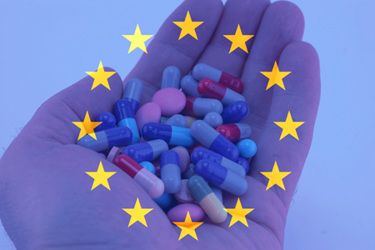EMA Issues New Draft Guideline: Chemistry Of Active Substances
By Tim Sandle, Ph.D.

Control of active substances (chemical entities) present in a medicinal product is fundamental, both for ensuring the efficacy of the medicine and for patient safety. Many drug products include multiple chemical transformation steps to separate the starting material from the final active substance. Manufacturers need to identify the substance(s) considered as the active substance starting material, which is the component that provides a significant structural fragment into the structure of the active substance.
To improve the new drug submission process in relation to the active substance, the European Medicines Agency (EMA) has issued a new draft guideline, titled Guideline on the chemistry of active substances.1
The draft guideline relates to granting a marketing authorization for a medicinal product. The guideline, once the final version is issued, will replace two existing documents: Note for guidance on chemistry of new active substances (CPMP/QWP/130/96, Rev 1) and Chemistry of active substances (3AQ5a). Hence, the new document will bring together new and existing active substances into one guideline. The draft is open for public consultation until Jan. 31, 2025.
To be listed as an “active substance,” an ingredient must undergo a drug approval process and receive approval from the relevant regulatory authority. The main purpose of the guideline is to detail the requirements for a new drug or modified drug application.
Structural Formula
The structural formula of an active substance needs to be provided. This includes the relative and absolute stereochemistry; the molecular formula and the relative molecular mass should be provided. The stoichiometric formula is important for understanding the relationship between the weights of reactants and products, including the optimum amount before, during, and following chemical reactions.2
The type of information supplied as evidence is derived from some or all of the following:
- elemental analysis with theoretical values
- infrared spectra with interpretation
- nuclear magnetic resonance spectra with interpretation
- UV characteristics, including pH dependent shifts
- mass spectra with interpretation (relative molecular mass)
- characteristic chemical reactions that are diagnostic of the structure of the molecule
- X-ray crystallography.
The minimum requirements for providing details about the active substance are:
- description
- identification
- impurities
- assay and/or potency.
General Properties
A list of physicochemical properties must be provided, detailing any that can affect pharmacological efficacy and toxicological safety. This includes solubilities, acid dissociation constant, polymorphism (the property of a solid-state chemical substance to exist in the solid state in different crystalline forms), isomerism, partition coefficient, permeability, and hygroscopicity, together with any other relevant properties.
Of these, hygroscopicity is an important measure. This refers to the process of attracting and holding water molecules via either absorption or adsorption. In drug development, this is an assessment of the amount of water vapor taken up by an active substance as a function of relative humidity. This itself is a function of the crystalline or amorphous form of a solid.3 This is particularly important for stability, over the drug’s shelf-life, for oral dosage forms.
For starting materials of herbal origin, additional details need to be provided to ascertain suitability. This is because of the greater risks stemming from adulterants like pesticides, microbiological contamination, heavy metals, mycotoxins, radioactive contamination, and residual solvents.4
A second form of active substance that requires attention to the risk assessment process are semi-synthetic substances. These materials present a risk of carryover of specific impurities from the fermentation process (such as DNA or proteins) to the final substance.5
Recovered Materials
If recovered materials are introduced into the process, then the recovery process for the active substance needs to be indicated within the reaction scheme, process description, and a block flow diagram.
The impact of the use of recovered materials must be documented in the overall process risk assessment. The main type of risk that needs to be identified and controlled is impurities. The risk assessment will need to detail potential impurities of concern, such as mutagenic impurities.
Generally, recovered materials should be avoided in manufacturing due to the inherent risks and limited to specific and predetermined situations. If recovered materials are to be included, creating a strong, science-based risk assessment, including an understanding of mutagenic and toxicological risks, represents an important task.6
Recovery of solvents, reactants, intermediates, or the API from the mother liquor (the residual liquid that remains after crystallization or isolation processes) or filtrate requires:
- an approved procedure and
- analytical evidence showing that recovered materials meet specifications and are suitable for their intended use.
Procedural Narrative
The guideline requires a “procedural narrative” to be provided. This is a description of the manufacture, detailing starting materials, solvents, reagents, depletion agents, recovered materials, catalysts, processing aids, gases, and materials used for quenching or workup. For each of these, their quantities (or ranges) need to be detailed, along with any catalysts used.
Developing a procedural narrative is, in this author’s opinion, something some manufacturers struggle with, and a returned submission requiring further work is often the consequence of an unclear procedural narrative.
An effective narrative should describe each step in the manufacturing process in sequential order and identify critical steps, critical process parameters, process controls employed, and ranges for process parameters (such as temperature, pressure, pH, time, and flow rate). To give the regulator confidence, the control of critical steps and intermediates should also be provided. Although it is not mentioned in the guideline, it may be useful to describe the development of any design spaces.
This description of the process should further indicate the scale of manufacture and the range for which the considered process may be used. The narrative should also contain the batch size or scale, together with the expected yield range.
For new drug products, the narrative summary should also describe the milestones in the development of the process and provide an explanation as to how these are connected to the assurance of product quality.
Other Information
Other forms of information that will need to be provided to the EMA, as required by the guideline, are:
- manufacturer’s details
- manufacturing process, including detail of each key step:
- mixing of multiple components
- phase change and phase separation steps
- steps where control of temperature and pH are required
- steps that introduce an essential molecular structural element or result in a major chemical transformation
- steps that introduce (or remove) significant impurities to (or from) the active substance
- final purification step
- For sterile products, evaluation studies for terminal sterilization or aseptic processing must be provided.
- starting materials, including an assessment of impurity risks (such as isomeric impurities and mutagens)
- specification of any starting materials of human or animal origin (including an assessment of transmissible spongiform encephalopathies and viral safety)
- reference standards
- details of solvents used during manufacturing
- material controls, including specific identification test and purity limits
- process controls
- chemical structures, molecular formulae, and molecular weight of the active substances
- any intended alternative processes
- justification for reprocessing and/or reworking, if either is intended
- container closure system
- stability data, including forced degradation studies and stress conditions.
With each submission, a description of batches and results of batch analyses should be provided.
Across the different requirements set out by the guideline, impurity profiling is emphasized as an important part of pharmaceutical analysis. This includes the identification, structural elucidation, and quantitative determination of impurities and their impact upon the final pharmaceutical formulation.
References
- EMA. Guideline on the chemistry of active substances, EMA/321776/2024: https://www.ema.europa.eu/en/documents/scientific-guideline/draft-guideline-chemistry-active-substances-revision-1_en.pdf
- Hofmeyr, J. S. (2001) Metabolic control analysis in a nutshell. Proceedings of the 2nd International Conference on Systems Biology: 291–300
- Newman AW, Reutzel-Edens SM, Zografi G. (2008) Characterization of the "hygroscopic" properties of active pharmaceutical ingredients. J Pharm Sci. 97(3):1047-59
- Haji A, Desalegn K, Hassen H. (2023) Selected food items adulteration, their impacts on public health, and detection methods: A review. Food Sci Nutr. 11(12):7534-7545
- Chen ZH, Zhou H, Wang S, et al. (2019) An Isolated Method and Assignment for Critical Impurities in Semi-Synthetic Process of Arbekacin Sulfate. Pharmazie. 74(6):352-356
- Szekely, G. (2015) In Mutagenic Impurities: Strategies for Identification and Control Edited by Teasdale, A, John Wiley & Sons, Inc., 2022, pp321-614.
About The Author:
 Tim Sandle, Ph.D., is a pharmaceutical professional with wide experience in microbiology and quality assurance. He is the author of more than 30 books relating to pharmaceuticals, healthcare, and life sciences, as well as over 170 peer-reviewed papers and some 500 technical articles. Sandle has presented at over 200 events and he currently works at Bio Products Laboratory Ltd. (BPL), and he is a visiting professor at the University of Manchester and University College London, as well as a consultant to the pharmaceutical industry. Visit his microbiology website at https://www.pharmamicroresources.com.
Tim Sandle, Ph.D., is a pharmaceutical professional with wide experience in microbiology and quality assurance. He is the author of more than 30 books relating to pharmaceuticals, healthcare, and life sciences, as well as over 170 peer-reviewed papers and some 500 technical articles. Sandle has presented at over 200 events and he currently works at Bio Products Laboratory Ltd. (BPL), and he is a visiting professor at the University of Manchester and University College London, as well as a consultant to the pharmaceutical industry. Visit his microbiology website at https://www.pharmamicroresources.com.
